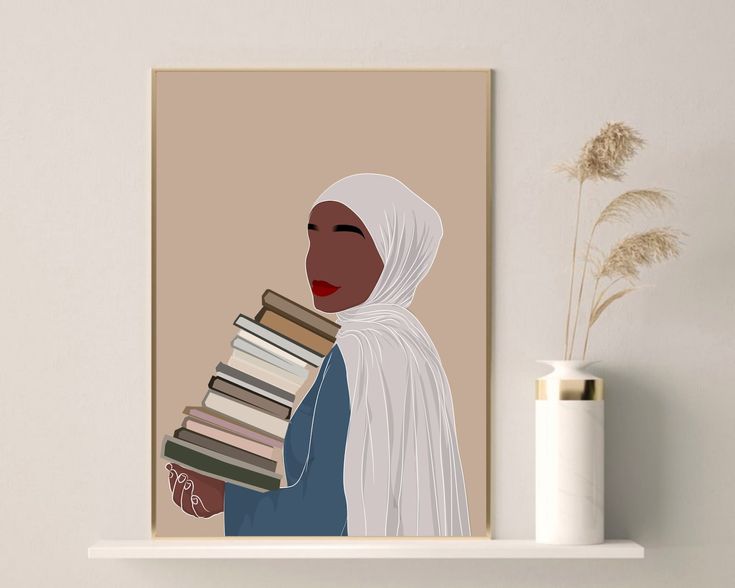Do you love this picture? If so, see it on Etsy here.
Empowering Women Against Islamophobia
In a world marked by diverse cultures and beliefs, the fight against discrimination and persecution requires collective action. That’s why I recommend combating the discrimination by empowering women against Islamophobia.
Women, irrespective of their religious backgrounds, can play a crucial role in promoting solidarity and combating Islamophobia through a simple yet powerful act: wearing scarves on their heads. This movement not only stands as an emblem of unity but also serves as an act of feminist activism, promoting civil and human rights globally.
Empowering Women Against Islamophobia
Kamala Harris was my inspiration (and no, its not what you think).
The inspiration for the idea of non-Muslim women wearing scarves as a gesture of solidarity struck me this morning while watching a video of an event featuring Kamala Harris. The video revealed an incident where two women wearing hijabs were seemingly denied entry, prompting me to reflect on the importance of raising awareness about the struggles faced by Muslim women and the broader issues of injustice and persecution, particularly in the context of the ongoing situation in Palestine.
Witnessing this exclusionary incident fueled my determination to encourage a visible and united stand against discrimination and silence. It underscored the need for non-Muslim women to express solidarity by embracing the simple act of wearing a scarf, turning a moment of exclusion into an opportunity for collective activism and advocacy for the rights and dignity of marginalized communities.
Breaking Stereotypes Through Fashion
The scarf, often associated with Islamic culture, has been unfairly stigmatized in many parts of the world. But women have the remarkable power to challenge and break stereotypes through their fashion choices, and one impactful way is by choosing to wear a headscarf in solidarity with Muslim women.
By adopting this cultural garment, women can challenge preconceived notions and dismantle stereotypes associated with it. This act goes beyond personal style; it becomes a statement against discrimination and a celebration of diversity. It transforms the headscarf from a symbol of difference into a symbol of unity, demonstrating that embracing cultural practices can be a powerful form of resistance against stereotyping. In choosing to wear a headscarf in support of Muslim women, women not only showcase the richness of cultural diversity but also contribute to reshaping societal perceptions, fostering a more inclusive and understanding world.
By embracing this piece of clothing, women can challenge stereotypes and misconceptions surrounding Islam and its followers. This act fosters a culture of understanding, highlighting the importance of unity and shared values.
I have added the headscarves I love to wear to a list called Accessories in my Amazon Influencer Store, which you can see here.

Historically Jews, Christians and Muslims all Wore Head Coverings
Even though today we may associate the wearing of a head covering with Islam, the tradition of women covering their hair actually holds significance across all the monotheistic religions, serving as a symbol of modesty, reverence, and devotion. In Islam, Muslim women wear the hijab as a visible expression of their faith and commitment to God.
You may have also noticed, particularly lately, that in Judaism, married Orthodox Jewish women often cover their hair with a scarf, hat, or wig (known as a sheitel) in an act referred to as “kisui rosh,” or covering of the head. The tradition stems from interpretations of Jewish law, particularly from the Talmud, and is done as a sign of modesty and adherence to religious laws.
Similarly, within Christianity, including Eastern Orthodoxy and Catholicism, women historically covered their heads during worship as a symbol of humility and respect before God. The practice of women covering their heads is primarily associated with specific verses found in the New Testament of the Christian Bible, particularly in the First Epistle to the Corinthians, written by the Apostle Paul. The relevant passage is 1 Corinthians 11:5–6 (New International Version):
“But every woman who prays or prophesies with her head uncovered dishonours her head—it is the same as having her head shaved. For if a woman does not cover her head, she might as well have her hair cut off; but if it is a disgrace for a woman to have her hair cut off or her head shaved, then she should cover her head.”
1 Corinthians 11:5-6
This passage is part of a larger discussion by Paul on the order and propriety of worship practices in the early Christian community.
While the styles and interpretations may vary, the practice of women covering their heads remains a shared aspect of monotheistic faiths, illustrating the diverse ways in which religious traditions converge on the expression of devotion and modesty.
Empowering Non-Muslim Women
Choosing to wear a headscarf in solidarity transcends religious boundaries. Non-Muslim women donning scarves signal their commitment to supporting marginalized communities and challenging discriminatory practices. This act transcends religious and cultural boundaries, transforming a piece of attire into a powerful emblem of solidarity.
By donning a headscarf, women express their commitment to challenging societal norms and promoting a collective front against discrimination. It symbolizes a shared determination to dismantle stereotypes and combat injustice, emphasizing that the struggle for women’s rights is universal. In this gesture of unity, women reclaim agency over their choices, asserting that empowerment lies not only in personal freedoms but also in advocating for the rights and dignity of others. It underscores the strength that emerges when diverse women unite to challenge systemic biases, fostering a global sisterhood that stands resilient against prejudice and injustice.
It becomes a symbol of empowerment, allowing women to stand together against prejudice and injustice, which are in dire need.
Feminism Knows No Borders
Feminism, at its core, advocates for equality and justice for all women. It is a universal movement that seeks equality, justice, and empowerment for women, regardless of their backgrounds. In the fight against discrimination and injustice, feminism must encompass the struggles faced by Muslim women and actively combat Islamophobia as well as the other injustices that are faced by women daily.
By addressing the intersectionality of gender and religion, feminism becomes a powerful force for dismantling stereotypes and prejudices. The commitment to equality extends beyond geographical borders, advocating for the rights of women of all faiths. Embracing the fight against Islamophobia within feminist discourse not only reinforces solidarity among women globally but also underscores the interconnectedness of various social justice movements, fostering a more inclusive and intersectional feminist agenda.
The fight for women’s rights should extend beyond cultural and religious affiliations, recognizing that feminism knows no borders. By joining a movement that aims to combat Islamophobia, women can contribute to a more inclusive and compassionate society.
Amplifying Voices
Wearing scarves in solidarity is a visual and vocal statement against discrimination. It amplifies the voices of Muslim women who face prejudice daily. Wearing a headscarf in solidarity with Muslim women transcends the realm of personal attire; it emerges as a powerful visual and vocal statement against the discrimination perpetuated by Islamophobia.
This simple yet profound act becomes a visible symbol of unity, challenging misconceptions and prejudices surrounding Muslim identity. By donning a headscarf, individuals actively confront the biases that contribute to the marginalization of Muslim women. It transforms the silence of discrimination into a collective voice that demands respect, understanding, and the recognition of the diversity within our societies. This visual and vocal statement not only amplifies the shared commitment to justice but also serves as a tangible gesture of empathy, fostering a more compassionate world where cultural and religious differences are celebrated rather than stigmatized.
The collective strength of women from various backgrounds sends a powerful message to policymakers and communities alike, urging them to address the root causes of discrimination and persecution.

A Stand for Human Rights
The scarf movement is not just about religious symbolism; it’s about human rights. Many Muslim women globally face discrimination, harassment, and even violence due to their choice of attire. Supporting Muslim women through the scarf movement is fundamentally about upholding basic human rights.
The choice to wear a headscarf, a personal and often religious decision, has unfortunately become a target for discrimination and prejudice. By standing in solidarity with Muslim women, the scarf movement becomes a collective defence of their right to practice their faith freely, without fear of persecution. This transcends cultural boundaries and underscores the universal principles of human dignity, freedom of expression, and the right to live free from discrimination.
The scarf movement serves as a poignant reminder that advocating for the rights of Muslim women is not only a matter of cultural sensitivity but an imperative commitment to safeguarding the inherent rights and dignity of every individual. By standing together, women can demand the right to practice one’s religion freely without fear of persecution, thereby upholding the principles of universal human rights.
Sparking Conversations
Choosing to wear scarves initiates conversations about diversity, inclusion, and tolerance. It provides an opportunity for women to engage with others, sharing perspectives and fostering a deeper understanding of different cultures and religious practices.
This symbolic gesture sparks dialogues that go beyond personal attire choices, delving into the broader issues of cultural understanding and acceptance. It becomes an invitation to engage in discussions about the rich tapestry of human experiences, fostering an environment where differences are acknowledged and celebrated.
These conversations contribute to breaking down stereotypes and dismantling preconceived notions, promoting a deeper appreciation for the diverse identities within our communities. In taking this step, individuals actively participate in reshaping narratives around Muslim women, paving the way for a more inclusive society where diversity is not only acknowledged but embraced as a source of strength and enrichment.
Building Bridges in a Divided World
In a world that sometimes seems divided along religious and cultural lines, the scarf movement serves as a bridge between communities. It fosters a sense of shared humanity, encouraging people to look beyond differences and focus on the values that unite us all—equality, justice, and freedom.
Non-Muslim women wearing a scarf in an act of fashionable defiance not only challenge societal norms but also create a way of supporting women in a world that seems more divided than ever. This bold fashion statement transcends traditional boundaries, serving as a visual declaration against discrimination while embracing the beauty of diversity.
It represents a collective stand for unity and solidarity, urging others to join the movement in breaking down barriers that separate us. In this act of fashionable defiance, individuals bridge the gaps between different communities, fostering understanding and reinforcing the idea that support for one another is not restricted by cultural or religious affiliations. It transforms fashion into a powerful tool for advocacy, making a bold statement that resonates far beyond the realm of personal style.
We Are One, But We Are Many
The philosophy of “safety in numbers” finds poignant application in the collective protection and support of individuals targeted or oppressed by societal systems. By standing together, even if we may not directly belong to a specific marginalized group, we can amplify the impact of our protest against discrimination. Wearing a scarf on our heads in solidarity with Muslim women who choose to wear hijabs becomes a powerful symbol of unity, signalling to those facing prejudice that they are not alone.
This collective action not only embraces the ethos of safety in numbers but also transcends cultural and religious boundaries, fostering a shared commitment to justice and equality. It transforms a seemingly individual act into a collective statement against discrimination, showing that, as a society, we reject any form of oppression and stand together to create a more inclusive and empathetic world.
In conclusion, the decision to wear scarves in solidarity against Islamophobia and global persecution is a transformative act of feminist activism. It transcends religious boundaries, amplifies the voices of marginalized women, and promotes a world where diversity is celebrated. By standing together, women can lead the way toward a more inclusive, tolerant, and compassionate future.

FOR MORE FANTASTIC FINDS, MAKE SURE TO VISIT MY STORE BELOW
Amazon has graciously invited me to take part in their Amazon Influencer Program. As such, I now have a storefront on Amazon. Don’t forget to check it out to see all my favourite products, such as my bookshelf, my summer and winter fashion finds, and my go-to holistic health products. Please note that some of my posts may contain affiliate links. If you click on an affiliate link and later make a purchase, I may receive a small commission. Clicking on an affiliate link may earn a commission but does not result in additional charges to you or cost you anything extra. However, it helps to support me to keep bringing you honest work.




This Post Has 2 Comments
What’s up, everything is going fine here and ofcourse every one is sharing
information, that’s really fine, keep up writing.
Hey very interesting blog!